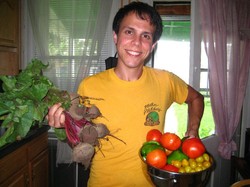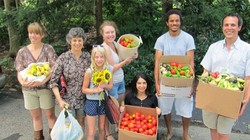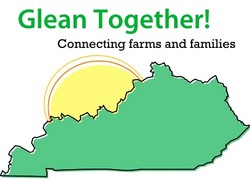It’s hard to believe that in a day and age where food insecurity hovers at a rate of about 1 in 6 people, 1.3 billion tons of food each year is wasted globally. 1.3 billion tons of food. I don’t know about all of you, but with numbers in the billions of tons, it’s difficult for me to understand the scale of such waste. 1.3 billion tons. That’s the equivalent of four-hundred and thirty three million average sized elephants. Thirteen million Boeing 757s. Over two and a half million times the mass of the International Space Station. 3,561 Empire State Buildings.
With the scale of such extravagant waste in mind, we sat down with Aaron Tornes from a Louisville non-profit Kentucky Interfaith Power and Light (KIPL) to discuss the ways his gleaning network—Glean Together!—is working to reduce the amount of waste in his local food system. Volunteers with Glean Together! collect leftover food that farmers do not want to take home with them from various farmers’ markets and deliver the fresh, local produce to organizations engaged in anti-hunger work. They also trek out to nearby farms to gather produce that farmers are unable to harvest.
 Presbyterian Hunger Program: What made you want to get involved in gleaning?
Presbyterian Hunger Program: What made you want to get involved in gleaning?
Aaron Tornes: My gleaning story began five years ago when I began to be exposed to different people, organizations and ideas that taught me the value of food. I was living in Nashville, and one of my friends was a dedicated advocate of food justice who was involved in Food Not Bombs (FNB), an organization that captures food from groceries before it goes to waste, cooks the food in their own kitchens and then feeds it to the homeless of the city every week. I got involved some with FNB and began asking questions about the state of the food system in the U.S. This led me to the works of great food authors like Wendell Berry, Michael Pollan, Eric Schlosser, Barbara Kingsolver and others. I began to understand just how much food was wasted in the U.S. every year, and I realized that gleaning could be a powerful counter-force to this cycle of waste.
PHP: How does gleaning help to address some of the roots causes of hunger?
AT: I have seen studies on the amount of food wasted in the U.S. every year which have ranged between 40-51%. That number represents food actually ready for harvest, whether it’s tomatoes, beans, beef, chicken or milk. This particular weakness in our food system is what makes the act of gleaning so effective. Gleaning is basically solving a logistical problem to access. When people decide to glean, this potentially wasted food, if we can manage it correctly, becomes a great resource to feeding people suffering from food insecurity. There is a vast amount of food to share with our neighbors if we can just get our hands on it before it makes it to the city dump or falls to the earth in the fields.
 PHP: Were there any obstacles in setting up a gleaning network that surprised you?
PHP: Were there any obstacles in setting up a gleaning network that surprised you?
AT: There have been no obstacles, only great opportunities. Like any new venture there are always things that you are unprepared for. I think the thing I was most unprepared for or unaware of was how much relationships would be the driving force behind our mission. I take pride in my relationships with our volunteers, the farmers we work with and their relationships to each other. We try to match volunteers to a specific farmers market so that there will always been a familiar face gleaning. Many of our volunteers have even started their own lists at their markets to help them remember the names of the farmers at each stand. I think that display of courtesy and desire to build a genuine relationship is what makes gleaning successful and sustainable. We need to be friends and neighbors with trust to make gleaning work, not just nameless do-gooders.
PHP: How did you decide which groups would receive the food?
AT: There is need for gleaned food across all cities but our main consideration is whether or not the food will be used at the place it is donated. If we bring too much or too little food someplace to donate then it just ends up where we don’t want it: the dump. Small food operations can’t take 4000 pound donations and large operations can’t put the resources in sorting and cooking 20 pounds of mixed vegetables. Therefore it is important to match the donation to the operation. We have partners like Dare to Care that can help up distribute multiple tons of food from a farm gleaning if we need them to. We are also partnered with small pantries and ministries that would rather have a few boxes of mixed produce to cook for the people they serve. By being intentional about donations this way we honor the work that the farmers have put into the food they give us.

PHP: Any advice that you would give to aspiring gleaners?
AT: I have just one piece of advice to people who want to start gleaning, and it is the name of our program: Glean Together! Create a community of caring people to share in the work of this great movement. When we glean together, we increase our capacity for fun and decrease our tendency to get burned out by over burdening already hectic schedules. Originally we had one volunteer to each market but now we try to assign more. One of our markets even has four gleaners! This way they can partner into two groups and glean the market on a bi-weekly basis. When they go to glean, they can look forward to having the same person right alongside them as they do the work. We also try to schedule regular potlucks for all of us to spend time with each other and catch up. Like I said before, relationships are the driving force of gleaning. Stick together and keep gleaning!